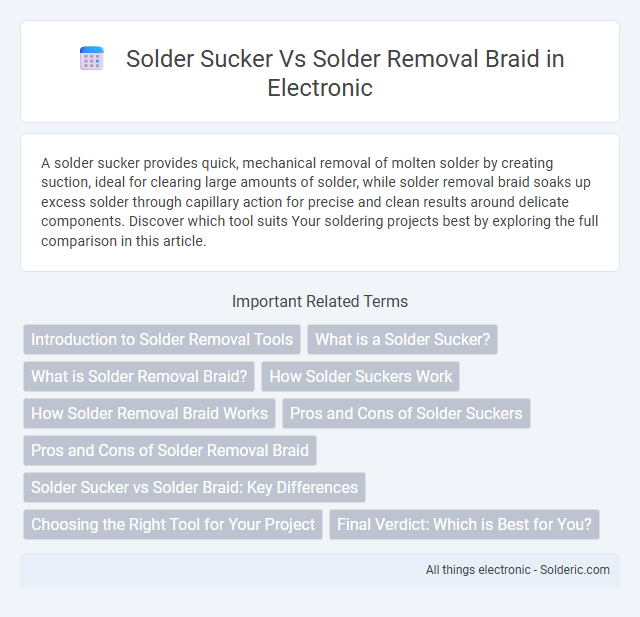A solder sucker provides quick, mechanical removal of molten solder by creating suction, ideal for clearing large amounts of solder, while solder removal braid soaks up excess solder through capillary action for precise and clean results around delicate components. Discover which tool suits Your soldering projects best by exploring the full comparison in this article.
Comparison Table
| Feature | Solder Sucker | Solder Removal Braid |
|---|---|---|
| Function | Vacuum suction tool to remove molten solder | Copper braid that absorbs molten solder by capillary action |
| Usage | Press plunger, heat solder, release plunger to suck solder | Place braid on solder, heat with iron, solder wicks into braid |
| Effectiveness | Efficient for quickly removing large solder amounts | Best for cleaning residual solder and small amounts |
| Reusability | Reusable with occasional cleaning | Single-use or limited reuse; replaces when saturated |
| Cost | Moderate initial investment | Low cost, consumable product |
| Portability | Handheld, portable | Small and lightweight |
| Ideal Use | Removing bulk solder from through-hole joints | Cleaning solder pads and removing fine solder traces |
Introduction to Solder Removal Tools
Solder suckers and solder removal braid are essential tools for effective solder removal in electronics repair and assembly. A solder sucker is a spring-loaded or vacuum-based device designed to quickly extract molten solder from joints, providing efficient solder removal in one suction action. Solder removal braid, made of fine copper wires, wicks away excess solder through capillary action when heated, offering precise control for cleaning solder pads and components.
What is a Solder Sucker?
A solder sucker is a hand-operated vacuum tool designed to quickly remove molten solder from electronic circuit boards during desoldering. It features a spring-loaded plunger that creates suction to lift liquid solder away from components, enabling clean and efficient repair or replacement. Compared to solder removal braid, a solder sucker is more effective for larger solder joints and rapid solder extraction.
What is Solder Removal Braid?
Solder removal braid, also known as desoldering wick, is a fine copper wire mesh coated with flux designed to absorb molten solder from circuit boards. It effectively cleans solder joints by capillary action, making it ideal for precise solder removal in electronics repair and assembly. Using your solder removal braid correctly ensures clean and damage-free surfaces for rework or component replacement.
How Solder Suckers Work
Solder suckers operate by creating a vacuum to quickly draw molten solder away from the joint, using a spring-loaded plunger that, when released, generates suction at the nozzle tip. This tool effectively removes large amounts of solder from through-hole or surface-mount pads, making it ideal for desoldering component leads. Unlike solder removal braid, which wicks away solder through capillary action, solder suckers provide faster and more controlled solder extraction during electronic repair or rework.
How Solder Removal Braid Works
Solder removal braid works by capillary action, drawing molten solder away from electronic components when heated with a soldering iron. Made of finely woven copper strands, the braid efficiently absorbs excess solder, preventing damage to circuit boards. Its effectiveness depends on the braid's width, thickness, and the solder type being removed.
Pros and Cons of Solder Suckers
Solder suckers offer quick and efficient removal of molten solder, making them ideal for desoldering through-hole components and large solder joints. Their reusable design provides cost-effectiveness over time, but they require manual operation and can sometimes leave small amounts of solder behind. You may find solder suckers less precise than solder removal braid, especially on delicate or tightly spaced surface-mount pads.
Pros and Cons of Solder Removal Braid
Solder removal braid offers precise control for desoldering small components and works well on tight spaces without requiring power, making it ideal for delicate or intricate electronic repairs. However, it can be less effective on large amounts of solder and may require repeated use, which can prolong the desoldering process. You might find the braid more user-friendly for quick, clean solder absorption but less efficient for heavy-duty solder removal compared to a solder sucker.
Solder Sucker vs Solder Braid: Key Differences
Solder suckers and solder removal braid both serve to remove molten solder but operate differently in precision and application. A solder sucker uses a vacuum to quickly extract large amounts of solder, ideal for desoldering components or clearing through-holes, whereas solder braid relies on capillary action to absorb excess solder, best for fine, detailed work on surface mount devices. Choosing between the two depends on your project requirements: solder suckers provide speed and power for heavy solder removal, while solder braid offers controlled, residue-free cleanup for delicate tasks.
Choosing the Right Tool for Your Project
Selecting between a solder sucker and solder removal braid depends on the specific requirements of your electronic project; solder suckers excel in quickly clearing large amounts of solder from through-hole components, while solder removal braid offers precision for fine, surface-mount work and delicate traces. Consider the circuit board type and component density--braid is ideal for tight spaces and preventing pad damage, whereas a solder sucker is efficient for bulk solder removal without contact risk. Evaluating factors such as heat sensitivity, workspace accessibility, and rework frequency ensures optimal solder removal performance and protects board integrity.
Final Verdict: Which is Best for You?
A solder sucker offers rapid, precise removal of molten solder, making it ideal for rework and through-hole components, while solder removal braid excels in cleaning residual solder and refining surface pads, especially on fine-pitch or surface-mount devices. Choosing between them depends on the specific task: use a solder sucker for bulk solder extraction and braid for detailed cleanup to prevent bridging and ensure pad integrity. Combining both tools often yields the best results in complex soldering projects.
solder sucker vs solder removal braid Infographic

 solderic.com
solderic.com